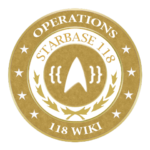We see the character archetype in movies, books and comics all the time – the solitary loner who’s too tough, cool or tormented to keep the company of anyone but him or herself. It’s a favorite of fiction writers because it allows an author to focus on the motivations and character journey of just one character while all others fall into the background; however in a roleplaying game like SB118 the lone wolf character is frequently a frustrating disruption to the game. A book or movie can choose to focus on a single character or an ensemble cast; but a roleplaying game must focus on an ensemble group of characters. Because the game is comprised of multiple players portraying unique characters, the best roleplaying stories focus either on shifting action that allows all characters to get involved or encompassing action where all characters work together.
Either way, the majority of fun in a roleplaying game comes from character interaction – whether you are working together to accomplish a goal or simply building relationships with the characters around you. A ‘lone wolf’ character can feel disconnected from the action (and therefore the fun) of the game; or they could fall into the danger of ‘grandstanding’ – which is when one character overshadows all the other characters in a scene, stealing the spotlight at the expense of others. These are two things we very much want to avoid in games because they create animosity and frustration between players.
Yet the lone wolf is an enduring archetype that appeals to many imaginations. Is there a way to do it correctly and portray a lone wolf character that can connect and work with your fellow players while still communicating the character’s intentions? Well, the answer is yes; but it’s very challenging to do so. The best lone wolf concepts that work are characters that have a clear background and reasoning for being a loner, with a future plan of connecting more with the group as past wounds are salved.
To put in a different way – simming is a group-narrative story structure. Every character needs to have a way of becoming part of the group narrative without stealing the focus away from the group. This means any lone wolf character needs a plan of how they can join and interact with the group in order to be a successful long term character. It can be dramatically interesting to watch the progression from distrustful loner to valued group member; but there always has to be some progression that binds the character to the group.
So the first question for any player wanting to play a ‘lone wolf’ character is: can you accept the challenge of having your character work towards an ever growing relationship with the group? Do you have a plan for how to maintain group interaction every step along the way? If the answer is no, and you see the character as always remaining a loner, this is probably a better character for fanfiction than a roleplaying game. If the answer is yes, let’s move forward.
The next advice in playing a reserved, loner character can also go for people that simply want to play shy characters and that’s: body language matters. If your character isn’t communicating much through their own voice; you as a player need to be carefully detailing your character’s body language and actions. This is what your fellow players will use to ‘imagine’ your characters role in the narrative – and if you don’t give them anything to work with your character will simply disappear from the narrative in their imagination. Make your character as present and real as possible in the minds of your fellow readers. Write details about facial tics, movement details, posture and stance. If this sounds exhausting – it is! Writing a silent character is much harder than a talkative one, but if you want to make it work it is essential you’re giving as much detail of your characters expressions and actions as possible.
Second, develop an internal monologue. Being able to write posts gives simmers a great advantage in expressing the thoughts and motivations of a silence character over tabletop roleplayers. You can start to inform your readers about a quiet character’s personality and drive through internal monologues. For example:
::Lieutenant Wharf stood quietly in the corner::
Isn’t very memorable or interesting. However, with some added internal monologue Wharf becomes a character with far more impact, despite the fact that he doesn’t say anything:
::Standing quietly in the corner Lieutenant Wharf’s posture was stiff and overly formal. He was following the conversation on the bridge but was unwilling to speak up:: oO It might be the Tholians, but I don’t have enough proof. If I say something now and end up wrong, I’ll look like a fool. It’s better to stay quiet until I know for sure. Oo
In the second one we get the sense that Wharf is biting his tongue because he’s worried the others on the bridge will see him as wrong or foolish. There’s a clear motivation for his silence, and he becomes a more empathetic character to the audience.
There’s some great upsides of putting internal monologue into a quiet character’s posts; but there can also be some downfalls to it as well. When you’re writing the internal musings of your character focus on that character – their motivations, perceptions and desires. Do not focus on your fellow PCs unless you are directly interacting with them, and never use internal monologues to post negative things about your fellow PCs that they cannot react to. Verbal conflicts between characters are an integral part of drama; but having one character ‘thought-posting’ that internal monologue without allowing the other character to react in game brings the conflict to an OOC level which we always want to avoid.
Remember that the entire goal of simming is interaction. Whether your character starts as a social butterfly or as a quiet wallflower you must interact to be a part of the story and enjoy the game. Whether that interaction is verbal or non-verbal you must focus on how you communicate to other characters in the game; and always have a plan for where your character is starting from and where they are going. A character who cuts off the rest of the characters in or waits for other players to come to him or her is not a suitable character for an interactive game; but a character willing to work on a character development journey and character interaction through creative means can be a compelling way to portray the lone wolf character.
Discuss this and other writing tips, tricks, and tools in our Writing Improvement forum.



















